Welcome to Santa Clara County, located in the heart of the beautiful Bay Area of California! Santa Clara County is home to a diverse and vibrant bird species, making it an excellent destination for bird watchers and nature enthusiasts.
With its wide variety of habitats, from grasslands to wetlands to coastal areas, the county is home to over 200 species of birds.
From the American Kestrel and the Red-tailed Hawk to the California Quail and the Yellow-billed Magpie, the county offers various birds to observe, feed, and admire.
Whether you’re an experienced birder or a beginner, you will find something interesting and exciting in Santa Clara County.
10 Birds to Watch in Santa Clara County
If you are a bird lover, you might be interested in this list of 10 birds to watch in Santa Clara County, California. Santa Clara County is located in the heart of the Bay Area and has a rich diversity of habitats and bird species.
Here are some of the birds that you can look for in your backyard or in the nearby parks and reserves.
1. Anna’s Hummingbird
Anna’s hummingbird is a species of hummingbird that is native to the western coastal regions of North America.
It was named after Anna Masséna, Duchess of Rivoli, who patronized the North American ornithology community. The Anna’s hummingbird is generally found in the United States and Canada along the western coasts.
However, in the early 20th century, they were found breeding only in the more southern regions, such as northern Baja California and Southern California. Anna’s hummingbird is a beautiful species, about 4-5 inches long, with a bright green back, head, and ruby red throat.
It is known for its powerful flight and remarkable ability to hover in place. Its diet comprises flower nectar, spider webs, small insects, and other food sources.
Anna’s hummingbird is quite an adaptable species, able to live in various environments, from deserts to forests. They are also hardy and can withstand colder temperatures than other hummingbird species.
Anna’s hummingbird is an important species to the North American ecosystem. It plays a vital role in pollinating many flowers and plants and provides food for many other animals, such as flycatchers, jays, and snakes.
| Kingdom | Animalia |
| Phylum | Chordata |
| Class | Aves |
| Clade | Strisores |
| Order | Apodiformes |
| Family | Trochilidae |
| Genus | Calypte |
| Species | C. anna |
2. Western Bluebird
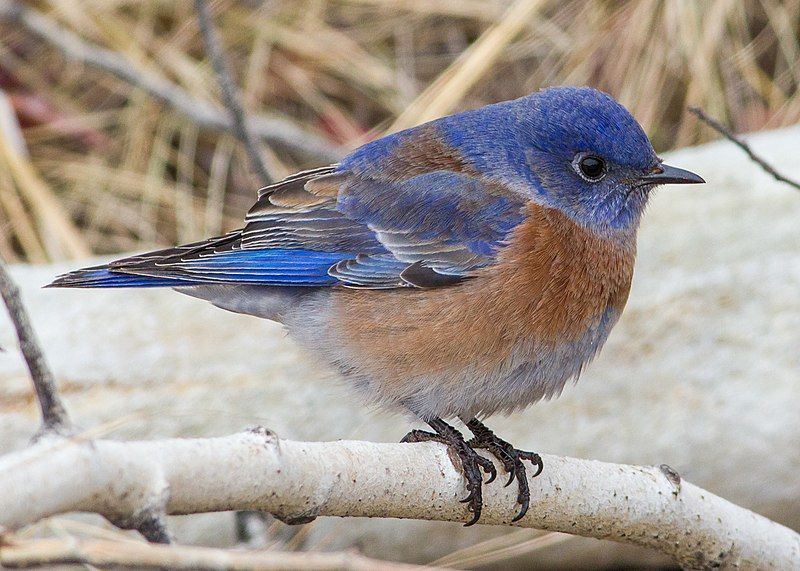
The western bluebird is a species of the thrush family native to western parts of North America. It is a small bird, measuring 16-20 cm long and weighing around 23-30 grams. Its wingspan is usually between 12-17 cm.
Western bluebirds have a bright blue back, wings, and tail, with a rust-colored breast and belly. The head is lighter blue, and the throat is white.
The bill is black, and the legs are gray. Western bluebirds inhabit various habitats, ranging from open woodlands to suburban gardens. They are most commonly seen in open areas with some trees, such as oak, willow, or cottonwood.
They feed primarily on insects but will also eat fruits and berries. They nest in cavities, either in trees or in artificial nest boxes. Western bluebirds are a widespread species and are not threatened. However, they are vulnerable to habitat destruction due to human development.
They are also threatened by competition from other cavity-nesting birds, such as house sparrows and starlings. To protect this species, it is essential to maintain a habitat suitable for western bluebirds and to prevent the spread of non-native bird species.
| Kingdom | Animalia |
| Phylum | Chordata |
| Class | Aves |
| Order | Passeriformes |
| Family | Turdidae |
| Genus | Sialia |
| Species | S. mexicana |
3. Chestnut-backed chickadee
The chestnut-backed chickadee, formally known as Parus rufescens, is a species of small bird belonging to the tit family, Paridae. This species is found in the western parts of North America, from Alaska in the north to California in the south.
It is particularly abundant in the Pacific Northwest, which covers the states of Washington, Oregon, and parts of Idaho and Northern California. The chestnut-backed chickadee has a distinct black cap, white cheeks, and a grey-brown back with a chestnut hue.
Its underside is usually lighter in color and may have some yellowish tinge. It has a short forked tail, and its wings are rounded.
Its call is a loud, cheerful “chick-a-dee-dee-dee” that can be heard in the forests it inhabits. This bird species is often seen in wooded areas, such as coniferous forests and mountain ranges. They usually feed on seeds, insects, and other small invertebrates.
They also nest in tree cavities, building their nests from moss, bark, and feathers. The chestnut-backed chickadee is an integral part of the bird population in the Pacific Northwest, and its presence indicates a healthy ecosystem.
It is an essential food source for many other species and helps keep insect populations in check. This bird species is also a necessary part of this region’s cultural and ecological fabric, as it has been a part of the landscape for centuries.
| Kingdom | Animalia |
| Phylum | Chordata |
| Class | Aves |
| Order | Passeriformes |
| Family | Paridae |
| Genus | Poecile |
| Species | P. rufescens |
4. Lesser Goldfinch
The lesser goldfinch is a small bird belonging to the New World goldfinch family. It is typically found in the Americas and forms a clade with the American goldfinch and Lawrence’s goldfinch, which are its relatives.
Males of lesser goldfinch species have a unique feature: a black forehead. This is a trait that females of the species do not have. It is typical for all three species of the New World goldfinches for males to have this trait.
| Kingdom | Animalia |
| Phylum | Chordata |
| Class | Aves |
| Order | Passeriformes |
| Family | Fringillidae |
| Genus | Spinus |
| Species | S. psaltria |
5. American Crow
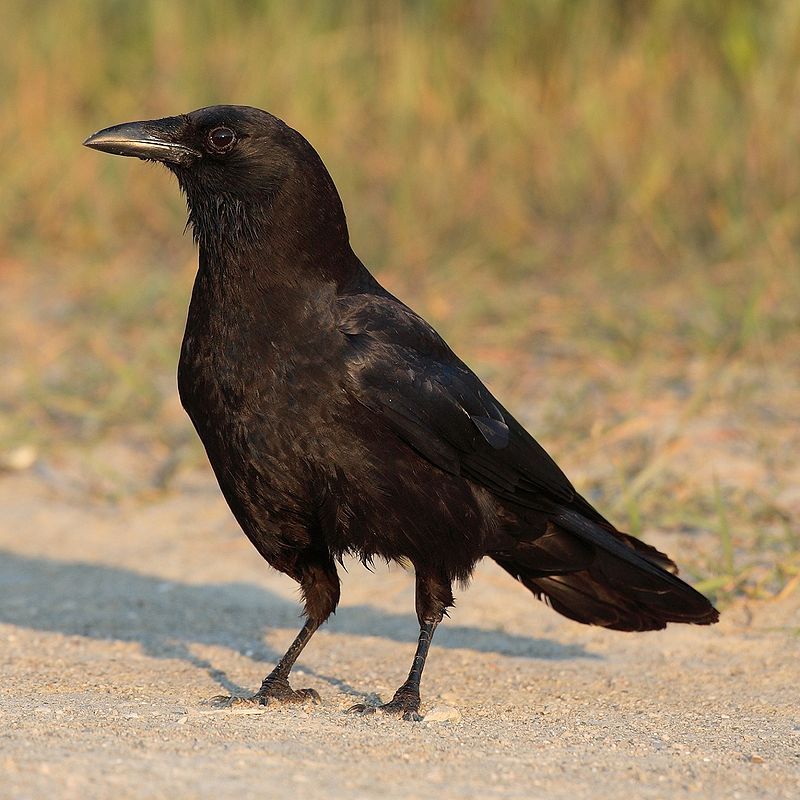
The American crow is a species of bird that belongs to the Corvidae family, which also includes jays, magpies, and ravens. It is a common bird found throughout much of North America, ranging from the northern United States and Canada to southern Mexico.
American crows are easily distinguished from other birds by their size and the presence of a fan-shaped tail. They are also known for their loud caws and communal roosting. American crows are the New World counterpart to the carrion crow and the hooded crow of Eurasia.
These birds all occupy the same ecological niche, which means they share similar habitats and diets. All three species are omnivorous, feeding on various foods, including fruits, grains, insects, and carrion.
American crows are highly adaptable and can live in rural and urban areas. They are often seen around garbage dumps and roadsides, where food is abundant. American crows are social birds that can often be seen in large flocks.
They are brilliant and have been observed using tools to obtain food and cooperating with one another to solve problems. Their ability to recognize and remember faces makes it difficult for them to hunt or trap.
They have been known to mob predators that threaten their nests and young. Overall, the American crow is a fascinating species of bird that has adapted to living in various habitats. Its intelligence and social behavior make it an interesting species to observe and study.
| Kingdom | Animalia |
| Phylum | Chordata |
| Class | Aves |
| Order | Passeriformes |
| Family | Corvidae |
| Genus | Corvus |
| Species | C. brachyrhynchos |
6. Black Phoebe
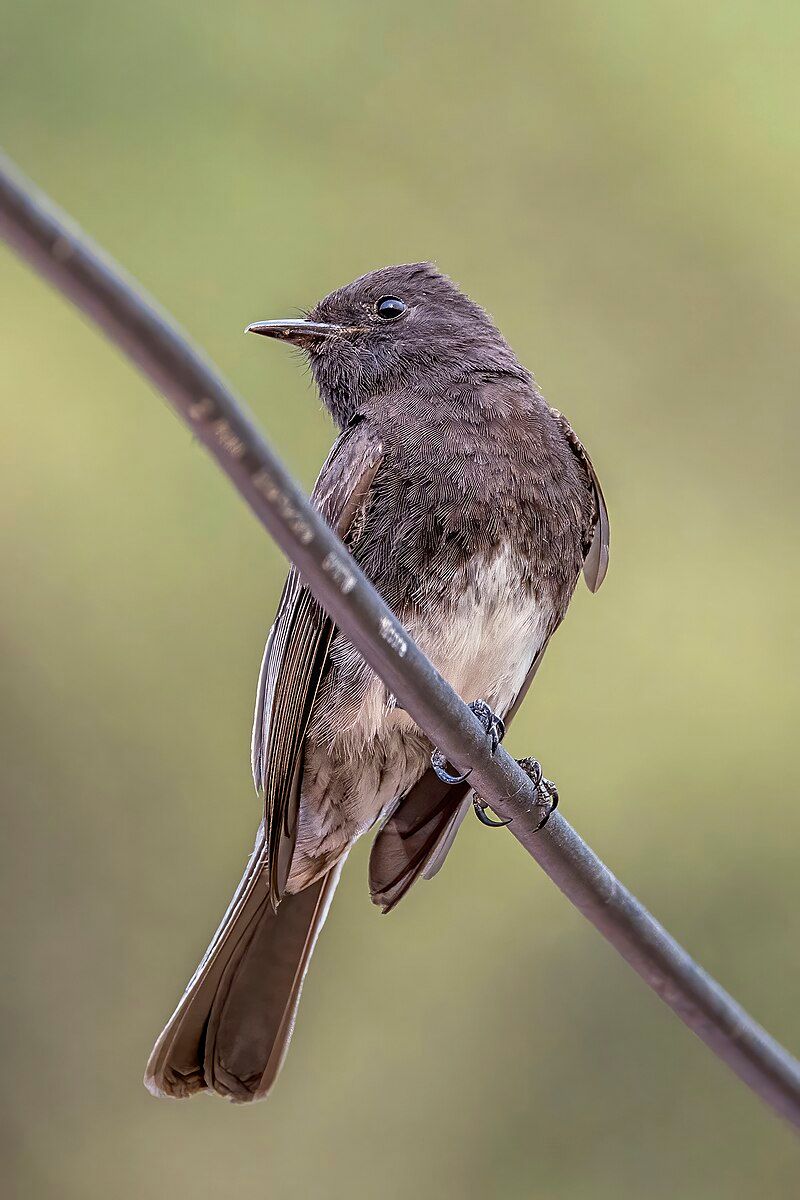
The black phoebe is a species of passerine bird belonging to the tyrant-flycatcher family of birds. It is native to the western United States, from southwest Oregon to California, and extends southward into Central and South America.
The black phoebe is present throughout most of its range throughout the year, though it migrates less than other species in its genus. However, the northern bird populations migrate seasonally, usually in the winter.
This species is known for its distinct black feathers and its unique call. It is a common sight along rivers and ponds, often perched on rocks and branches.
The black phoebe is an integral part of the ecosystem, as it is a natural predator of insect pests, helping to keep the populations of these species in check.
| Kingdom | Animalia |
| Phylum | Chordata |
| Class | Aves |
| Order | Passeriformes |
| Family | Tyrannidae |
| Genus | Sayornis |
| Species | S. nigricans |
7. California Scrub Jay
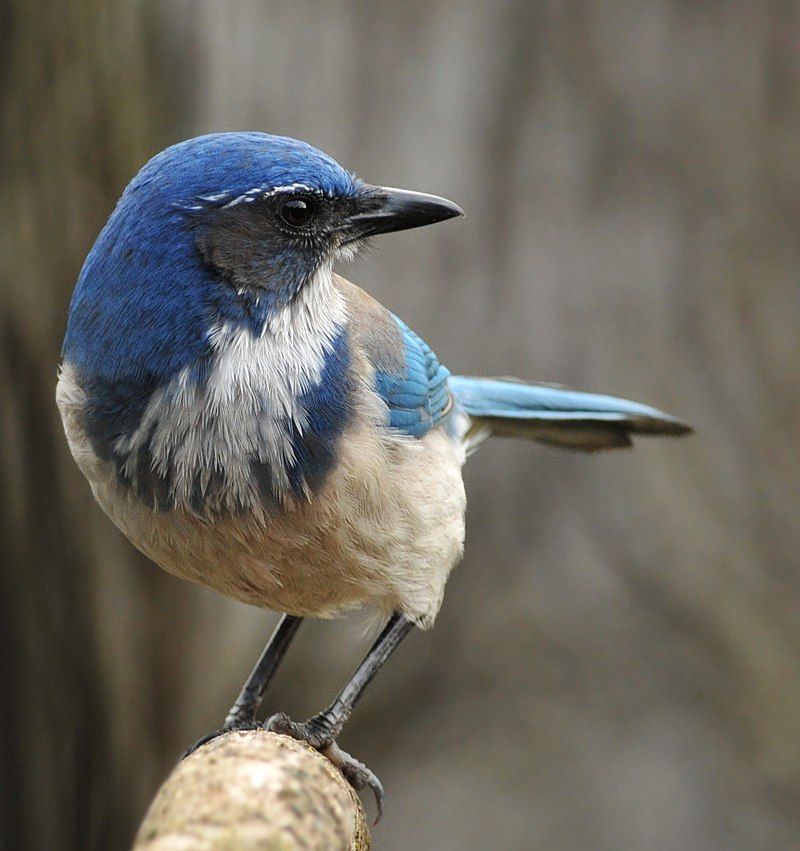
The California scrub jay is a bird species native to western North America. It is most commonly found in the region stretching from southern British Columbia in Canada to California in the United States and west Nevada near Reno.
This bird is a permanent resident of the area and is often seen west of the Sierra Nevada mountain range. The California scrub jay is a medium-sized bird 8-11 inches long. It has a grayish-blue head, chest, wings, and a white belly.
Its back and wings are barred with black and white. Its distinctive crest is black and white, and its bill is black. The California scrub jay is an omnivorous species, feeding on various foods, including insects, fruits, nuts, seeds, and eggs.
It is an intelligent species known for its problem-solving abilities and ability to remember where food is stored. It is also known for its acrobatic flying skills, which it uses to elude its predators.
The California scrub jay is integral to the western North American ecosystem. It plays an essential role in the dispersal of plant seeds, which helps maintain the local vegetation’s health.
It is also an important food source for larger predators such as hawks, owls, and coyotes. The California scrub jay is a species of conservation concern. It is threatened by habitat loss and competition with other species.
As a result, it is listed as a species of particular concern by the IUCN. Conservation efforts are underway to protect and restore the species’ habitat and ensure survival.
| Kingdom | Animalia |
| Phylum | Chordata |
| Class | Aves |
| Order | Passeriformes |
| Family | Corvidae |
| Genus | Aphelocoma |
| Species | A. californica |
8. Dark-eyed Junco
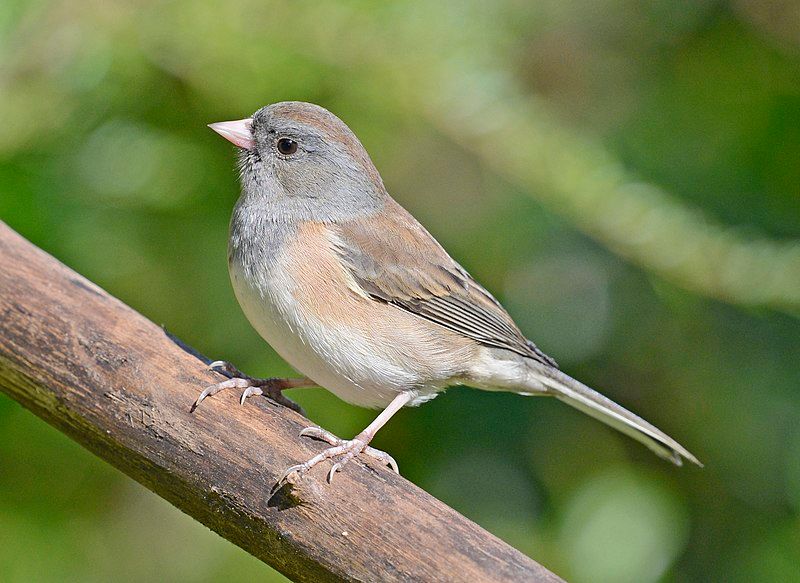
The dark-eyed junco is a small, grayish sparrow species found throughout much of North America. It is an incredibly adaptable bird, allowing it to survive and thrive in a wide range of temperatures, from temperate climates to the far reaches of the Arctic.
Its ability to adjust to different climates has spread across much of the continent. This bird is also very similar to the related fox sparrow, making its systematics (the study of its classification) a bit more complicated.
Despite this, the dark-eyed junco is still a widespread bird, making it a recognizable sight for birdwatchers and nature enthusiasts.
| Kingdom | Animalia |
| Phylum | Chordata |
| Class | Aves |
| Order | Passeriformes |
| Family | Passerellidae |
| Genus | Junco |
| Species | J. hyemalis |
9. California Towhee
The California towhee is a species of bird belonging to the Passerellidae family, native to the coastal regions of western Oregon and California in the United States and Baja California and Baja California Sur in Mexico.
This species has had its taxonomy debated, with some experts believing it is closely related to the sparrow family. In contrast, others argue it is distinct enough to be placed in a family.
The debate over the taxonomy of the California towhee is primarily based on its physical characteristics. Some of the traits that are used to distinguish the towhee from other birds include its size, coloration, and vocalizations.
The California towhee has a brown back and wings, white underparts, and a white throat. It also has a black-streaked crest and white spots on its wings. Its song is a series of chirps and trills, and its call is a sharp “tow-hee.”
The debate over the taxonomy of the California towhee has been ongoing for many years. While some experts argue that the species should be placed in its own family, others believe it is more closely related to the sparrow family.
This debate has been fueled by the difficulty in distinguishing the towhee from other species and the lack of clear scientific evidence to support either argument.
No matter which side of the debate one falls on, it is clear that the California towhee is a unique species that deserves further study. As more research is conducted, the taxonomic discussion on this species will hopefully be resolved.
| Kingdom | Animalia |
| Phylum | Chordata |
| Class | Aves |
| Order | Passeriformes |
| Family | Passerellidae |
| Genus | Melozone |
| Species | M. crissalis |
10. Golden-crowned Sparrow
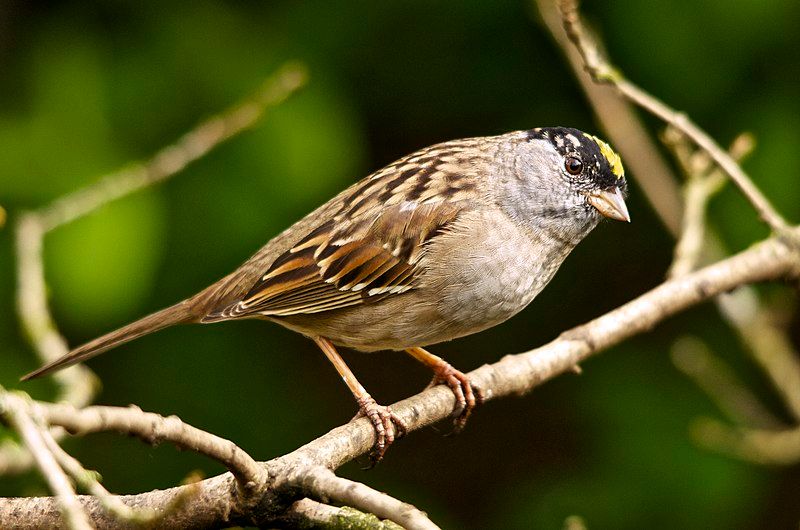
The golden-crowned sparrow is a passerine bird species found in western North America. It is a large sparrow, measuring up to 6 inches long and weighing up to 14 grams. The adult has a grayish-brown back and wings, white underparts, and a yellowish-orange crown.
The male has a bright yellow face and throat, while the female has a duller yellowish coloration.
During the breeding season, the male has a distinctive black stripe from the crown to the bill. The golden-crowned sparrow is found in coastal areas, from Alaska to northern California, and in the Rocky Mountains.
They inhabit open forests, shrublands, and grasslands and can be found in both urban and rural areas. During the winter, they migrate south to areas of California, Arizona, and New Mexico. The diet of the golden-crowned sparrow consists of insects, seeds, and berries.
They often forage in flocks, searching for food on the ground or in low shrubs. They also feed on nectar and have been observed hovering to sip it from flowers. The golden-crowned sparrow is a vocal species, and its melodious song is often heard in its habitat.
It is an important species for conservation and is listed as Least Concern by the International Union for Conservation of Nature.
| Kingdom | Animalia |
| Phylum | Chordata |
| Class | Aves |
| Order | Passeriformes |
| Family | Passerellidae |
| Genus | Zonotrichia |
| Species | Z. atricapilla |
Conclusion
Santa Clara County is home to a diverse array of birds, many native to the area. Birdwatchers and nature lovers can enjoy the many species of resident and migratory birds throughout the county.
The Santa Clara Valley Audubon Society and other organizations are dedicated to the conservation of birds in the area, and their efforts have been instrumental in protecting the county’s avian population.